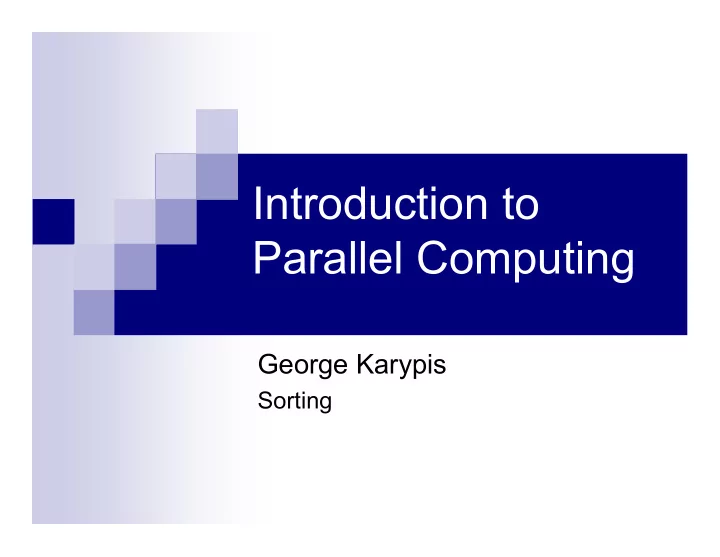

Introduction to Parallel Computing George Karypis Sorting
Outline � Background � Sorting Networks � Quicksort � Bucket-Sort & Sample-Sort
Background � Input Specification � Each processor has n/p elements � A ordering of the processors � Output Specification � Each processor will get n/p consecutive elements of the final sorted array. � The “chunk” is determined by the processor ordering. � Variations � Unequal number of elements on output. � In general, this is not a good idea and it may require a shift to obtain the equal size distribution.
Basic Operation: Compare-Split Operation Single element per processor Multiple elements per processor
Sorting Networks � Sorting is one of the fundamental problems in Computer Science � For a long time researchers have focused on the problem of “how fast can we sort n elements”? � Serial � nlog(n) lower-bound for comparison-based sorting � Parallel � O(1), O(log(n)), O(???) � Sorting networks � Custom-made hardware for sorting! � Hardware & algorithm � Mostly of theoretical interest but fun to study!
Elements of Sorting Networks � Key Idea: � Perform many comparisons in parallel. � Key Elements: � Comparators: � Consist of two-input, two-output wires � Take two elements on the input wires and outputs them in sorted order in the output wires. � Network architecture: � The arrangement of the comparators into interconnected comparator columns � similar to multi-stage networks � Many sorting networks have been developed. � Bitonic sorting network � Θ (log 2 (n)) columns of comparators.
Bitonic Sequence Bitonic sequences are 7 graphically represented 6 4 by lines as follows: 12 0
Why Bitonic Sequences? � A bitonic sequence can be “easily” sorted in increasing/decreasing order. Bitonic Split s s 1 s 2 • Every element of s 1 will be less than or equal to every element of s 2 • Both s 1 and s 2 are bitonic sequences. • So how can a bitonic sequence be sorted?
An example
Bitonic Merging Network � A comparator network that takes as input a bitonic sequence and performs a sequence of bitonic splits to sort it. � +BM[n] A bitonic merging � network for sorting in increasing order an n - element bitonic sequence. � -BM[n] Similar sort in decreasing � order.
Are we done? � Given a set of elements, how do we re-arrange them into a bitonic sequence? � Key Idea: � Use successively larger bitonic networks to transform the set into a bitonic sequence.
An example
Complexity � How many columns of comparators are required to sort n= 2 l elements? � i.e., depth d ( n ) of the network?
Bitonic Sort on a Hypercube � One-element-per-processor case � How do we map the algorithm onto a hypercube? � What is the comparator? � How do the wires get mapped? What can you say about the pairs of wires that are inputs to the various comparators?
Illustration
Communication Pattern
Algorithm Complexity?
Bitonic Sort on a Mesh � One-element-per-processor case � How do the wires get mapped? Which one is better? Why?
Row-Major Shuffled Mapping Complexity? Can we do better? What is the lowest bound of sorting on a mesh? communication performed by each process
More than one element per processor � Hypercube � Mesh
Bitonic Sort Summary
Quicksort
Parallel Formulation � How about recursive decomposition? � Is it a good idea? � We need to do the partitioning of the array around a pivot element in parallel. � What is the lower bound of parallel quicksort? � What will it take to achieve this lower bound?
Optimal for CRCW PRAM � One element per processor � Arbitrary resolution of the concurrent writes. � Views the sorting as a two-step process: � (i) Constructing a binary tree of pivot elements � (ii) Obtaining the sorted sequence by performing an inorder traversal of this binary tree.
Building the Binary Tree Complexity?
Practical Quicksort � Shared-memory � Data resides on a shared array. � During a partitioning each processor is responsible for a certain portion. � Array Partitioning: � Select & Broadcast pivot. � Local re-arrangement. � Is this required? � Global re-arrangement.
Efficient Global Rearrangement
Practical Quicksort � Complexity Complexity for message-passing is similar assuming that the all-to-all personalized communication is not cross-bisection bandwidth limited.
A word on Pivot Selection � Selecting pivots that lead to balanced partitions is importance � height of the tree � effective utilization of processors
Sample Sort � Generalization of bucket sort with data-driven sampling � n/p elements per-processor. � Each processor sorts is local elements. � Each processor selects p-1 equally spaced elements from its own list. � The combined p(p-1) set of elements are sorted and p-1 equally spaced elements are selected from that list. � Each processor splits its own list according to these splitters into p buckets. � Each processor sends its ith bucket to the ith processor. � Each processor merges the elements that it receives. � Done.
Sample Sort Illustration
Sample Sort Complexity Assumes a serial sort
Recommend
More recommend